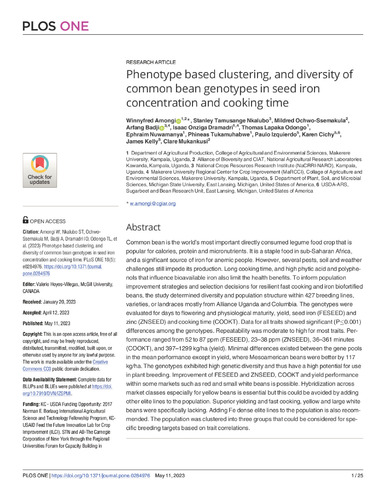Phenotype based clustering, and diversity of common bean genotypes in seed iron concentration and cooking time
Common bean is the world’s most important directly consumed legume food crop that is popular for calories, protein and micronutrients. It is a staple food in sub-Saharan Africa, and a significant source of iron for anemic people. However, several pests, soil and weather challenges still impede its production. Long cooking time, and high phytic acid and polyphenols that influence bioavailable iron also limit the health benefits. To inform population improvement strategies and selection decisions for resilient fast cooking and iron biofortified beans, the study determined diversity and population structure within 427 breeding lines, varieties, or landraces mostly from Alliance Uganda and Columbia. The genotypes were evaluated for days to flowering and physiological maturity, yield, seed iron (FESEED) and zinc (ZNSEED) and cooking time (COOKT). Data for all traits showed significant (P≤0.001) differences among the genotypes. Repeatability was moderate to high for most traits. Performance ranged from 52 to 87 ppm (FESEED), 23–38 ppm (ZNSEED), 36–361 minutes (COOKT), and 397–1299 kg/ha (yield). Minimal differences existed between the gene pools in the mean performance except in yield, where Mesoamerican beans were better by 117 kg/ha. The genotypes exhibited high genetic diversity and thus have a high potential for use in plant breeding. Improvement of FESEED and ZNSEED, COOKT and yield performance within some markets such as red and small white beans is possible. Hybridization across market classes especially for yellow beans is essential but this could be avoided by adding other elite lines to the population. Superior yielding and fast cooking, yellow and large white beans were specifically lacking. Adding Fe dense elite lines to the population is also recommended. The population was clustered into three groups that could be considered for specific breeding targets based on trait correlations.

